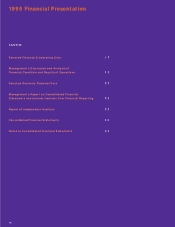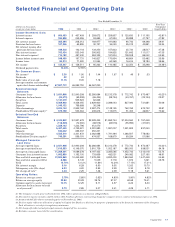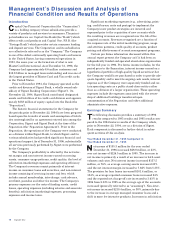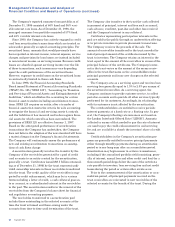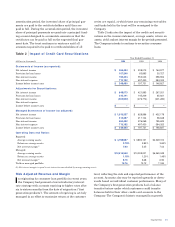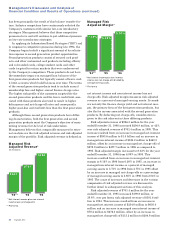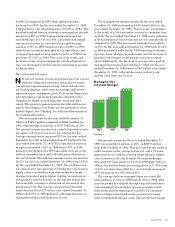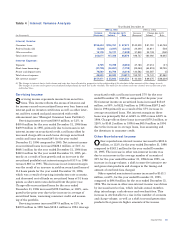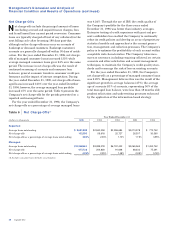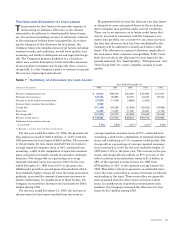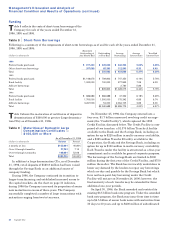Capital One 1996 Annual Report Download - page 22
Download and view the complete annual report
Please find page 22 of the 1996 Capital One annual report below. You can navigate through the pages in the report by either clicking on the pages listed below, or by using the keyword search tool below to find specific information within the annual report.Capital One
Management’s Discussion and Analysis of
Financial Condition and Results of Operations (continued)
20
The Company’s reported consumer loan portfolio as of
December 31, 1996 consisted of 64% fixed and 36% vari-
able interest rate loans. As of December 31, 1996, the
managed consumer loan portfolio consisted of 57% fixed
and 43% variable interest rate loans.
Since 1990, the Company has actively engaged in credit
card loan securitization transactions which are treated as
sales under generally accepted accounting principles. For
securitized loans, amounts that would previously have
been reported as interest income, interest expense, service
charges and provision for loan losses are instead included
in non-interest income as servicing income. Because credit
losses are absorbed against servicing income over the life
of these transactions, such income may vary depending
upon the credit performance of the securitized loans.
However, exposure to credit losses on the securitized loans
is contractually limited to these cash flows.
In June 1996, the Financial Accounting Standards
Board issued Statement of Financial Accounting Standards
(“SFAS”) No. 125 (“SFAS 125”), “Accounting for Transfers
and Servicing of Financial Assets and Extinguishments of
Liabilities,” which establishes the accounting for certain
financial asset transfers including securitization transac-
tions. SFAS 125 requires an entity, after a transfer of
financial assets that meets the criteria for sale accounting,
to recognize the financial and servicing assets it controls
and the liabilities it has incurred and to derecognize finan-
cial assets for which control has been surrendered. The
provisions of SFAS 125 are effective January 1, 1997.
Based on the anticipated performance of securitization
transactions the Company has undertaken, the Company
does not believe the adoption of the new standard will have
a material impact on the Company’s financial statements.
The Company will continuously assess the performance of
new and existing securitization transactions as assump-
tions of cash flows change.
A securitization generally involves the transfer by the
Company of the receivables generated by a pool of credit
card accounts to an entity created for the securitization,
generally a trust. Certificates issued ($8.5 billion outstand-
ing as of December 31, 1996) by the trust represent undi-
vided ownership interests in those receivables transferred
into the trust. The credit quality of the receivables is sup-
ported by credit enhancement, which may be in various
forms including a letter of credit, a cash collateral guaran-
ty or account, or a subordinated interest in the receivables
in the pool. The securitization results in the removal of the
receivables from the Company’s balance sheet for financial
and regulatory accounting purposes.
The receivables transferred to a securitization pool
include those outstanding in the selected accounts at the
time the trust is formed and those arising under the
accounts from time to time until termination of the trust.
The Company also transfers to the trust the cash collected
in payment of principal, interest and fees such as annual,
cash advance, overlimit, past-due and other fees received
and the Company’s interest in any collateral.
Certificates representing participation interests in the
pool are sold to the public through an underwritten offering
or to private investors in private placement transactions.
The Company receives the proceeds of the sale. The
amount of receivables transferred to the trust exceeds the
initial principal amount of the certificates issued by the
trust to investors. The Company retains an interest in the
trust equal to the amount of the receivables in excess of the
principal balance of the certificates. The Company’s inter-
est in the trust varies as the amount of the excess receiv-
ables in the trust fluctuates as the accountholders make
principal payments and incur new charges on the selected
accounts.
The Company acts as a servicing agent and receives loan
servicing fees generally equal to 1.5% to 2.0% per annum of
the securitized receivables. As a servicing agent, the
Company continues to provide customer service, to collect
past-due accounts and to provide all other services typically
performed for its customers. Accordingly, its relationship
with its customers is not affected by the securitization.
The certificateholders are entitled to receive periodic
interest payments at a fixed rate or a floating rate. In gen-
eral, the Company’s floating rate issuances are based on
the London Interbank Offered Rate (“LIBOR”). Amounts
collected in excess of that needed to pay the rate of interest
are used to pay the credit enhancement fee and servicing
fee and are available to absorb the investors’ share of credit
losses.
Certificateholders in the Company’s securitization pro-
gram are generally entitled to receive principal payments
either through monthly payments during an amortization
period or in one lump sum after an accumulation period.
Amortization may begin sooner in certain circumstances,
including if the annualized portfolio yield (consisting, gener-
ally, of interest, annual fees and other credit card fees) for a
three-month period drops below the sum of the certificate
rate payable to investors, loan servicing fees and net credit
losses during the period or certain other events occur.
Prior to the commencement of the amortization or accu-
mulation period, all principal payments received on the
trust receivables are reinvested in new receivables of the
selected accounts for the benefit of the trust. During the








